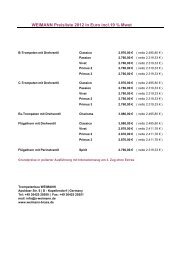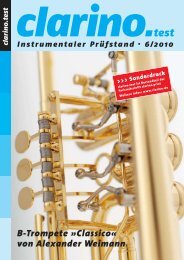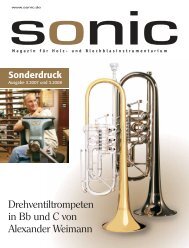Create successful ePaper yourself
Turn your PDF publications into a flip-book with our unique Google optimized e-Paper software.
clarino.test<br />
Instruments on the test stand 6/2010<br />
B trumpet »Classico«<br />
by <strong>Alexander</strong> <strong>Weimann</strong><br />
>>> Special print. clarino.test is part of the specialist magazine clarino.print<br />
More information: www.clarino.de<br />
Passionate<br />
Bb trumpet »Classico« by <strong>Alexander</strong> <strong>Weimann</strong><br />
On <strong>Alexander</strong> <strong>Weimann</strong>’s homepage you can read that »It has always been our aim to<br />
provide each musician with an instrument that allows them to realize their individual<br />
ideas of the sound, which can be achieved by varied possible combinations«<br />
Our testers Rainer Hauf and Dominikus Schmelzer are absolutely convinced of the tested<br />
Bb trumpet »Classico«. If you had to testimonialise this trumpet, you would come up<br />
with an overall rating of »summa cum laude«.<br />
In Kapellendorf, situated in the picturesque federal state of Thuringia, they are not only<br />
masters of their trade, but here they actually work precisely with passion.<br />
The tested instrument, a Bb trumpet »Classico«, is made of gold brass, and gold plated<br />
in the version that we had. The bell, with a final diameter of 140 mm, makes a massive<br />
impression, and it has been bent by hand, just like the crook.<br />
For the brass instrument maker Dominikus Schmelzer the overall impression is extremely<br />
positive. The surface is smooth and slightly polished at the sockets. “The »Classico« has<br />
been made and soldered beautifully straight and symmetrically. The instrument feels<br />
comfortable in your hand, it is neatly built. It is an obviously hand made instrument, but<br />
nevertheless – or that is why? – the measurements, the design of the braces and the<br />
overall concept are optically sophisticated”, so the conclusion of the testing craftsman.<br />
Cone-shaped construction of the machine<br />
The rotary valve machine that has been used comes from Zirnbauer, and according to<br />
Schmelzer it runs “as well as usual”. In this context, the musical tester Rainer Hauf<br />
noticed that “the response is very free, open and direct”. The resistance remains the<br />
same throughout all registers and leaves nothing to be desired. “As I had not<br />
experienced that before, I was wondering why this was such a striking feature of this<br />
instrument.” The reason: a cone-shaped machine 11.05 – 11.2 mm was built into the<br />
trumpet. The cone-shaped construction, which Zirnbauer introduced for rotary valve
trumpets in 1996, allows the especially well-balanced characteristics of the instrument<br />
when the main slide and the bell are accordingly tuned.<br />
Here, the middle register does not stand out very much from the low and high registers.<br />
The resistance is reduced through an optimized airflow in the valves. This leads to a very<br />
open blowing feel with a beautifully centred core.<br />
The cone-shaped lead pipe is inserted into a cylindrical nickel-silver tube, and thus offers<br />
the possibility to remove the lead pipe. The chosen lead pipe of 148 mm is quite long,<br />
which leads to a slight shift of weight towards the bell.<br />
“It does not feel awkward at all, as the instrument lies perfectly balanced in your hand”,<br />
says Schmelzer. There is a MINIBAL joint on the third slide and an overblow key on the<br />
tuning slide crook for C3. Water key, overblow key and trigger lever are cushioned with a<br />
cork pad, so there is no noise when pressing them.<br />
The assessment of an instrument often stands and falls with the spontaneous feel good<br />
factor. If the musician has to “struggle” with it at the beginning, it will be tough for the<br />
instrument. If the musician feels good from the very first moment, it will be the first plus.<br />
The latter is the case with the »Classico«. “The trumpet lies perfectly balanced in your<br />
hand, and from the first tones it shows its strength”, states Rainer Hauf. The instrument<br />
responds immediately to the smallest amount of air, and converts the lip vibration into<br />
tones. “This is something I have not experienced before” the tester is enthused. The<br />
response is very direct and clear, which conveys an easy and secure blowing feel. At<br />
each dynamic level the air flows freely and with little resistance through the instrument.<br />
You are never forced to push more air or to push harder. The sound remains solid and<br />
stable. “My students, who blew this instrument too, have confirmed this feeling.” The<br />
musician should never have the feeling that the instrument could let him down.<br />
The intonation leaves nothing to be desired<br />
Also where intonation is concerned the trumpet leaves nothing to be desired. You can<br />
play the instrument without spending a lot of time to get accustomed to it, and you will<br />
find all tones in exactly the right place. “That was something I liked very much, as it is<br />
often a problem with German trumpets”, Hauf sums up. Especially in the high mid-range<br />
and in the high registers this means an enormous saving of power, as you do not have to<br />
“bend” the tones. Besides that, there is no risk of slipping into another natural tone.<br />
The trumpet comes with a big and round tone. When playing piano it is stable and<br />
singing, when playing forte it is very bright and centred. “You are present without being<br />
in the foreground. In churches you can play dark tones, and for signals you can produce
a brighter tone”, explains Rainer Hauf the instrument as being extremely practicable. The<br />
sound spectrum is very wide, and thus makes a number of applications possible: from<br />
the brass quartet up to the symphony orchestra.<br />
And, there is another top mark “excellent” for the <strong>Alexander</strong>-<strong>Weimann</strong>-Trumpet in one<br />
more category: There are definitely no bad tones.<br />
Also from a musical point of view, the machine was positively assessed by Rainer Hauf.<br />
The Zirnbauer valve runs very nicely and smoothly. The articulation of tones when<br />
playing trills and fast figures is very good and direct. The air flow is very pleasing when<br />
changing tones.<br />
However, in the practical test Rainer Hauf has noticed a slight problem with the action.<br />
When taking out the 3rd slide, the slide push-rod suddenly re-bounces. It is not easy to<br />
replace it easily after draining out the water. Quickly getting the water out, as it is often<br />
necessary in practice, is quite risky, because you do not know if the slide is ready for use<br />
in short time. “I think this needs to be improved”, demands Hauf. “But it is not supposed<br />
to be a great challenge for the brass maker.” Rainer Hauf’s suggestion: “A water key on<br />
the 3rd valve would be an option.”<br />
The price/performance ratio (at a basic price of 2,820 EUR) is very good, because the<br />
trumpet absolutely comes up to the requirements of professional players, and it<br />
represents another top product in the segment of German trumpets for professional<br />
players.<br />
Register coordination is well balanced<br />
The register coordination is well balanced due to the cone-shaped structure of the<br />
machine. You feel comfortable in each register, and the sound can develop very well.<br />
Due to the excellent workmanship – certified by the craftsman, who tested the<br />
instrument – and the outstanding musical and practical features – as presented by the<br />
musical-practical tester – the <strong>Weimann</strong>-trumpet »Classico« is an absolute top<br />
instrument. There are, however, some additional characteristics that make it even more<br />
remarkable. A red screw on the water key for example, marks the <strong>Alexander</strong> <strong>Weimann</strong>’s<br />
models for professional musicians.<br />
This is just an optical element, and it is not relevant for practical issues, but in the overall<br />
picture it is an eye-catcher. And the eye must be pleased as well.
Moreover, several lead pipes make it possible for the player to vary sound and response.<br />
A trumpet with a wide sound spectrum and easy, direct response is probably something<br />
each player wishes to have. With this instrument, this span has been covered extremely<br />
well, and it enables the player to produce a large bandwidth of tone colours.<br />
The air can flow freely through the instrument in all registers, and thus convey a<br />
comfortable blowing feel. The trumpet is very versatile, too. Whether it be a brass<br />
quintet, a brass ensemble of ten, Egerlaender brass music, church music, a brass<br />
orchestra or a symphony orchestra – no matter what the instrumentation is –playing it is<br />
always fun and convenient. Just “summa cum laude”.<br />
Redaktion: Klaus Härtel<br />
>>> clarino.argument<br />
+ The response is very free, open and direct<br />
+ The intonation is excellent, which means it is an enormous saving of power, especially<br />
in the middle and high register<br />
+ When playing piano, the sound is very stable and singing, when playing forte it is very<br />
bright and centred<br />
– When taking out the 3rd slide, the slide push-rod suddenly re-bounces, and it is not<br />
easy to replace it after letting the water drain out.<br />
>>> clarino.factbox<br />
Manufacturer: <strong>Alexander</strong> <strong>Weimann</strong><br />
Material: Gold brass, gold plated<br />
Bell, hand hammered: 140 mm<br />
Bore: between 11.05 and 11.2 mm<br />
Special feature: Zirnbauer machine with one-piece tuning slides and valve joints of gold<br />
brass, 3 rd slide trigger,<br />
Hand-forged braces, removable lead pipe, C key<br />
Recommended price:<br />
Basic price 2,820.00 EUR<br />
Gold plated 3,690.00 EUR<br />
Supplier/Information:<br />
<strong>Alexander</strong> <strong>Weimann</strong>
Apoldaer Straße 6<br />
99510 Kapellendorf<br />
Tel: +49 (0) 3 64 25 / 2 05 50<br />
Fax: +49 (0) 3 64 25 / 2 05 51<br />
info@a-weimann.de<br />
www.weimann-brass.de<br />
The testers<br />
Rainer Hauf studied the trumpet at the Richard-Strauss-Conservatory and at the<br />
University for Music and Performing Arts, Munich, and he participated in a number of<br />
master classes (among others, German Brass and Günther Beetz). At present, the<br />
musician works as a teacher for brass instruments at a Secondary school, the St.-<br />
Thomas-Gymnasium in Wettenhausen. He gives a lot of concerts as a soloist, but also<br />
with the Nördlinger Bach Trumpet Ensemble that he has founded.<br />
Dominikus Schmelzer trained as a brass instrument maker with Wenzel Meinl in<br />
Geretsried, where he also completed an additional year in tuba, cimbasso, and bass<br />
trumpet making. In 2004 he finished further education and received his master<br />
craftsman’s diploma as a brass instrument maker, and nowadays he is the Managing<br />
Director of Musikhauses Frei in Marktoberdorf.







